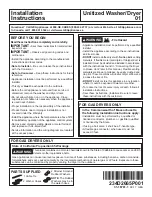
7
6. INSTRUCTIONS FOR INSTALLERS
6.1
PREPARING FOR INSTALLATION
Carry out the following operations:
-
place the appliance in the desired position on a solid, flat and stable floor;
-
take care not to damage the appliance by banging it against nearby objects during loading and
offloading operations;
-
Only qualified personnel, equipped with safety measures, can be present in the area during installation;
-
Remove the appliance from its packaging, taking care not to damage any protruding parts (drains,
wiring, power cable);
-
remove the protective film;
-
Check that the appliance is in good condition. In the event of visible damage to the appliance contact
the retailer and the courier responsible for delivering the product immediately. If in doubt do not use the
appliance until it is checked by a specialised technician;
-
transport and move the appliance using a fork-lift by inserting the forks under the appliance.
-
carefully level the appliance by using the levelling feet;
-
clean the appliance before using it with a cloth dampened in water and bicarbonate or other neutral
detergents and dry carefully.
6.2
WARNINGS
-
Prior to connecting the machine to the power and water supply read the general instructions and the
information indicated on the data plate by the manufacturer.
-
Do not leave the machine in rooms with a temperature lower than 0° C;
-
The degree of protection of the machine is IP X4. Therefore it should not be washed with direct high-
pressure water jets;
-
In the event of damage or breakdown switch off the appliance immediately.
-
Only use original spare parts to replace damaged ones..
6.3
LAWS, TECHNICAL REGULATIONS AND GENERAL RULES
Comply with the following during installation:
a) safety norms;
b) laws in force in the country where the appliance is installed;
c) read all the indications given in this handbook carefully as they provide important information for safe
installation, use and maintenance;
d) keep this handbook in a safe place for future reference by those who use the appliance;
6.4
INSTALLATION
Installation, start-up and maintenance of the appliance should only be carried out by specialised personnel in
compliance with the instructions provided by the manufacturer.
The manufacturer declines all responsibility if the appliance malfunctions due to incorrect installation,
tampering, improper use, poor maintenance, failure to comply with the local laws and inexperience in using
the appliance.
7. CONNECTING THE WATER SUPPLY
Prior to connecting the appliance to the water supply make sure that a gate valve or tap has been placed
between the water supply system and the appliance that allow the power supply to be interrupted if needed
or if repairs are required.
The water supply minimum pressure, measured when water enters the machine during the final rinse (flux
pressure), should not be lower than 2 bar, even in the presence of other open taps on the same line.
We recommend that each machine is equipped with its own pipe having reduced length and a sufficiently
large cross section so as to avoid pressure or load losses.
An additional rinsing pump, available as an optional item, must be installed in cases where pressure is lower
than the minimum value required.
A pressure reducing valve must be installed upstream from the supply pipe in cases where static pressure is
greater than 5 bar. The supply pipe of the machine must have a capacity equal or greater than 20 lt/min.
A successful final rinse cycle is strictly dependent upon adherence to the values shown.
The drain hose must be connected directly to the drain duct after a siphon has been interposed.
Drainage occurs by gravity, therefore the joint to the drain hose must always be positioned below the bowl
level.
Summary of Contents for SC40A
Page 1: ...INSTALLATION USE AND MAINTENANCE MANUAL GLASSES WASHERS FRONT LOADING DISH WASHER...
Page 21: ...21 Copper electric system PA Nylon wash circuit...
Page 22: ...22 21 INSTALLATION DIAGRAMS...
Page 23: ...23...
Page 24: ...24...








































